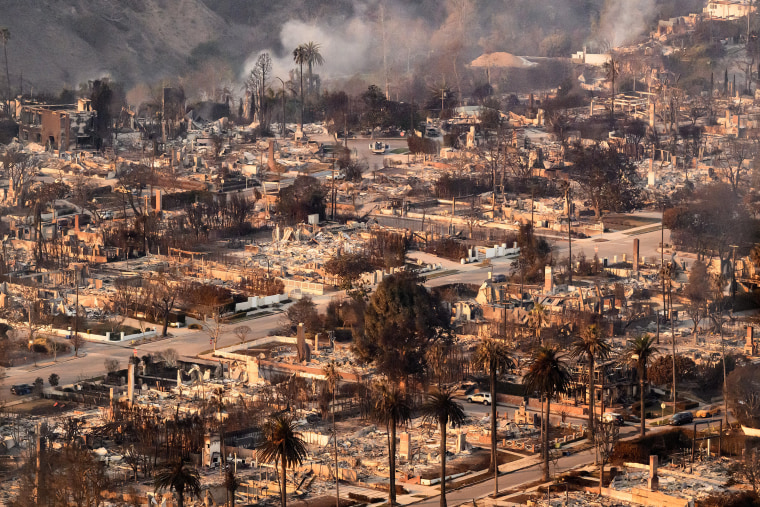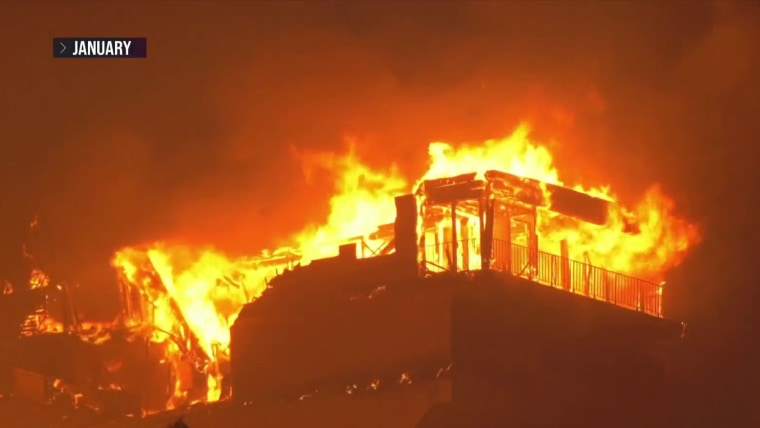A 29-year-old former Uber driver was arrested and charged in connection with the Palisades Fire in January, one of the most destructive wildfires in Los Angeles history, authorities said at a news conference Wednesday.
Authorities allege that Jonathan Rinderknecht "maliciously" set the fire, which killed a dozen people. It was fully contained on Jan. 31.
Rinderknecht was arrested Tuesday near his home in Florida on a charge of destruction of property by means of fire, Bill Essayli, acting U.S. Attorney for the Central District of California, said on X.

Authorities said the Palisades Fire was a “holdover” fire, or a continuation of the Lachman Fire, which Rinderknecht is alleged to have started on New Year’s Day.
Firefighters were able to suppress the Lachman Fire but did not know that it continued to smolder and burn underground, a criminal complaint says.
On Jan. 7, as heavy winds swept through the area, the fire began to surface and spread, becoming the Palisades Fire.
Rinderknecht, who previously lived in the Pacific Palisades neighborhood, had just finished working as an Uber driver when he started the blaze, according to the complaint. Two of the passengers he picked up told investigators that Rinderknecht appeared “agitated and angry,” the complaint says.
Uber told NBC Los Angeles that he was immediately removed from accessing the platform after it learned of his involvement and that it continues to work with authorities on the investigation.
Authorities allege that after he dropped off a passenger in Pacific Palisades, Rinderknecht drove toward Skull Rock Trailhead, tried to contact a former friend and then walked up the trail.
Authorities said he took photos on his cellphone and listened to a song by a French artist "whose music video included things being lit on fire," the Justice Department said in a news release.
Authorities said that at around 11:47 p.m., he took two videos on top of the hill and that no fires were visible, according to the complaint. Around 12:12 a.m. on Jan. 1, sensors indicated a fire in the area.
Authorities said Rinderknecht tried to call 911 several times but could not get through because his cellphone was out of range, the complaint says. He was eventually able to reach a 911 operator and report the fire. A nearby resident had also reported the fire.
Authorities said Rinderknecht fled in his car but turned around and followed fire trucks responding to the blaze. Just after 1 a.m., he took videos of the scene as firefighters tried to put out the fire, the news release alleges.
"A single person’s recklessness caused one of the worst fires Los Angeles has ever seen, resulting in death and widespread destruction in Pacific Palisades," Essayli said in a statement. "While we cannot bring back what victims lost, we hope this criminal case brings some measure of justice to those affected by this horrific tragedy."
Investigators said other possible factors, including fireworks, lightning and power lines, were determined not to be the cause of the fire.
California Gov. Gavin Newsom thanked the federal Bureau of Alcohol, Tobacco, Firearms and Explosives and the Department of Justice.
"I hope it gives some some closure as it relates to some of the anxiety that may have been felt. How did this happen? Who’s responsible? Can this happen again? What lessons we learned," Newsom said.
A report is coming out examining the preparedness for the fire and the response to it, Newsom said. The first phase of the report from the Fire Response Research Institute is due to be released the week of Oct. 20, he said.
Also Wednesday, the Los Angeles Fire Department released its after-action report about the first 36 hours of the response to the Palisades Fire.
That report said the LAFD “balanced fiscal responsibility with proper preparation for predicted weather and fire behavior by following the LAFD predeployment matrix,” but that the ferocity of the blaze and conditions overwhelmed the immediately available fire units.
“The initial response dispatched to the Palisades incident lacked the appropriate resources for the weather conditions typically associated with Red Flag conditions that the Department would normally respond with,” the report said.
It said specific engines were requested instead of the closest available, which delayed response times.
There was also a delay in communicating evacuation orders and warnings, the reports said.
“As a result, spontaneous evacuations occurred without structured traffic control, causing citizens to block strategic routes to the fire,” the report said.

